Snowshoeing
Are you tired of being cooped up inside during the winter months? Do you wish you were back in the mountains hiking? Are you looking for a new outdoor adventure to try? Maybe you should consider snowshoeing!
Snowshoeing is a fun and accessible way to explore the winter wilderness. It's a low-impact activity that allows you to hike through deep snow, offering a unique way to experience the beauty of the winter landscape.
Snowshoeing is a type of hiking that involves wearing special shoes (called snowshoes) that allow you to walk on top of deep snow without sinking down into it. The shoes are designed with a large, flat surface area, which helps to distribute your weight evenly and prevent you from sinking.
Snowshoeing can be done in any location that receives snowfall, including mountains, forests, and even urban parks. Just make sure to dress appropriately for the weather and check local trail conditions before you go. Access is often the biggest consideration to hiking your favorite summer spots with snowshoes on your feet. Forest roads often go unplowed through the winter months so, either you find a spot closer to open roads and parking, or plan a much further snowshoe expedition.
Not only is it a great way to get some fresh air and exercise, but it also allows you to experience the beauty of the winter landscape in a way that you can't on skis or a snowboard. Plus, it's a relatively easy activity to learn, making it accessible to people of all ages and fitness levels.
How do you get started with snowshoeing? First, you'll need to purchase or rent a pair of snowshoes. Look for a pair that fits your weight and the type of terrain you'll be exploring. You'll also want to invest in warm, waterproof clothing and a pair of sturdy winter boots. Then, find a local trail or park and give it a try! Don't be afraid to ask for tips or advice from more experienced snowshoers, as they can help you get the most out of your new hobby.
So why wait? Embrace the cold and try snowshoeing this winter. You'll be glad you did!
Here's some of our favorite snowshoe trails
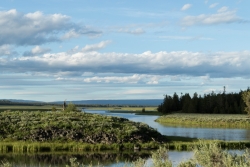
Harriman State Park
Island Park, Idaho
8.3 miles SW of Island Park, IdahoHarriman State Park is found 38 miles from Yellowstone along Henry's Fork. This 11,000-acre wildlife refuge is open year round for most activities. In addition to having beautiful scenery and...
Cross-country Ski, Hike, Horseback, Mountain Bike, Snowshoe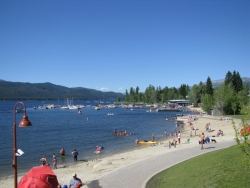
Mccall Area
McCall, Idaho
10.4 miles NE of McCall, IdahoMcCall is a beautiful resort town located in western Idaho, two hours north of Boise. It's feautures a multitude of activity of activities in both the Winter and Summer months, including:...
Backpack, Camp, Canoe, Cross-country Ski, Hike, Kayak, Mountain Bike, Sled, Snowshoe, Swim 0.6 mi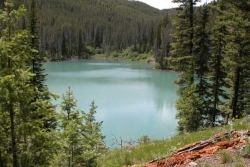
Packsaddle Lake
Tetonia, Idaho
9.3 miles W of Tetonia, IdahoPacksaddle is one of the less well known lakes/trails in the area. If you've got a good offroad vehicle, you can probably make it all the way to the end of the road, otherwise, it's just an...
Dive, Hike, Mountain Bike, Snowshoe, Swim 1.1-4.7 mi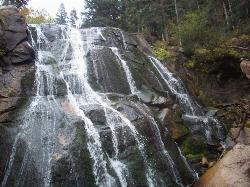
Bells Canyon
Sandy, Utah
1.9 miles E of Sandy, UtahBells Canyon is a moderate, 4.5 mile hike that begins in a residential area and ends at a waterfall in the enter of the canyon's forest. The first 1/2 mile of the hike is relatively...
Backpack, Hike, Mountain Bike, Snowshoe
Brushy Creek
Vandervoort, Arkansas
7.5 miles E of Vandervoort, ArkansasBrushy Creek is a day use hiking, picnic and swimming area in the Ouachita National Forest. This is the perfect place for visitors hoping for a peaceful day reconnecting with nature. There are...
Hike, Snowshoe 1.2 mi
Ghost Falls Trail
Sandy, Utah
5.0 miles S of Sandy, UtahGhost Falls is located in the corner canyon riding area of Draper, Utah and one of the first mountain bike routes in the canyon. It's a family-friendly hike, named for the...
Hike, Mountain Bike, Snowshoe 16.6 mi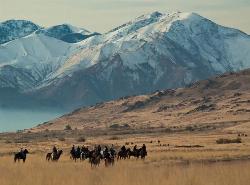
Antelope Island Figure 8
Layton, Utah
14.5 miles SW of Layton, UtahThe vistas are awesome, the rock formations are beautiful, and the silence is something you don\\'t experience much these days. You WILL feel like you are on another planet when you are in the...
Hike, Mountain Bike, Snowshoe 7.2 mi
White Rock Loop
Syracuse, Utah
10.5 miles SW of Syracuse, UtahLocated on Antelope Island near Syracuse, Utah, the White Rock Loop is an easy trail perfect for viewing the magnificent landscape views while hiking or biking around. Dogs which are kept on leashes...
Hike, Mountain Bike, Snowshoe 3.8 mi
Kelly Mountain Trail
Ririe, Idaho
8.2 miles E of Ririe, IdahoKelly Canyon Trail is a moderate, uphill trail that can be used by hikers, mountain bikers, and ATV riders. The trail features views of hills, mountains, trees, wildflowers, and some wildlife. Dogs...
Cross-country Ski, Hike, Mountain Bike, Snowshoe 7.1 mi
Mill Creek Trail
Moose, Wyoming
15.3 miles NW of Moose, WyomingThere are two ways to do this ride, one as a loop with the Targhee road providing the bulk of the climb, or as an out and back (up the trail and back down). Keep in mind that this trail is...
Cross-country Ski, Mountain Bike, Snowshoe- Plan Ahead and Prepare. Know the regulations and special concerns for the area you'll visit. Prepare for extreme weather, hazards, and emergencies. Schedule your trip to avoid times of high use. Visit in small groups when possible. Consider splitting larger groups into smaller groups. Repackage food to minimize waste. Use a map and compass to eliminate the use of marking paint, rock cairns or flagging.
- Travel & camp on durable surfaces. Durable surfaces include established trails and campsites, rock, gravel, dry grasses or snow. Protect riparian areas by camping at least 200 feet from lakes and streams. Good campsites are found, not made. Altering a site is not necessary.
- Dispose of waste properly. Pack it in, pack it out. Inspect your campsite and rest areas for trash or spilled foods. Pack out all trash, leftover food and litter. Deposit solid human waste in catholes dug 6 to 8 inches deep, at least 200 feet from water, camp and trails. Cover and disguise the cathole when finished. Pack out toilet paper and hygiene products. To wash yourself or your dishes, carry water 200 feet away from streams or lakes and use small amounts of biodegradable soap. Scatter strained dishwater.
- Leave what you find. Preserve the past: examine, but do not touch cultural or historic structures and artifacts. Leave rocks, plants and other natural objects as you find them. Avoid introducing or transporting non-native species. Do not build structures, furniture, or dig trenches.
- Minimize campfire impacts. Campfires can cause lasting impacts to the environment. Use a lightweight stove for cooking and enjoy a candle lantern for light. Where fires are permitted, use established fire rings, fire pans, or mound fires. Keep fires small. Only use sticks from the ground that can be broken by hand. Burn all wood and coals to ash, put out campfires completely, then scatter cool ashes.
- Respect wildlife. Observe wildlife from a distance. Do not follow or approach them. Never feed animals. Feeding wildlife damages their health, alters natural behaviors, and exposes them to predators and other dangers. Protect wildlife and your food by storing rations and trash securely. Control pets at all times, or leave them at home. Avoid wildlife during sensitive times: mating, nesting, raising young, or winter.
- Be considerate of other visitors. Respect other visitors and protect the quality of their experience. Be courteous. Yield to other users on the trail. Step to the downhill side of the trail when encountering pack stock. Take breaks and camp away from trails and other visitors. Let nature's sounds prevail. Avoid loud voices and noises.

















